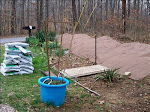1. Recycling is probably the easiest thing you can do to go green! It even cuts up to 1,000 pounds of annual carbon dioxide emissions that contribute to global warming. Even though you do recycle, you can be even “greener” by choosing products with the least amount of packaging possible and by choosing easily recyclable packaging, like paper or glass; very few municipal recycling programs accept plastics other than those labeled #1 and #2. You can help reduce pollution just by putting that soda can in a different bin. If you're trying to choose between two products, pick the one with the least packaging. If an office building of 7,000 workers recycled all of its office paper waste for a year, it would be the equivalent of taking almost 400 cars off the road. The energy saved by recycling a can of Coke could run a TV for three hours.
2. Replacing just one 75-watt incandescent bulb with a 19-watt CFL cuts 75 pounds of carbon dioxide emissions per year and up to 750 for the life of the bulb, not to mention the money savings on your energy bill. (Yes, these bulbs contain mercury and must be recycled as do ALL fluorescent bulbs. Compact fluorescent light bulbs (CFLs) last 10 times longer than a standard bulb and use at least two-thirds less energy.
3. Take your own bags to the grocery store.
4. Set you’re a/c thermostat on 77 degrees F or higher. Or set the heat on 68 degrees—and wear a sweater. Lowering your thermostat one degree can save you 5% on your energy bill. Change the air filters so your system doesn't have to work overtime.
5. Underinflated tires decrease fuel economy by up to three percent and lead to increased pollution and higher greenhouse gas emissions. Low tire Pressure is no joke. Not only is it safer to regularly check your tire pressure, but if 11,973 people kept their tires properly inflated, we’d save enough gasoline to drive a hybrid car around the entire Earth!
6. Drink from reusable containers. Single-use plastic juice and water bottles add to the growing stream of solid waste and should be recycled. But a reusable #2, #4 or #5 plastic or stainless steel water bottle is a worthy, earth-easy replacement.
7. Hand washing dishes can actually use up to 50 percent more water than a water-saving, energy-efficient dishwasher. But before you celebrate, check the date on your dishwasher. Those made before 1994 use more water than current models, so it may be time for an upgrade to an Energy Star-rated model, which is 41% more efficient than the federal standard. Even if you have a brand-new, hyper-efficient model, you can still conserve water and energy. Only run full loads, and don’t waste time and water pre-rinsing dishes; new models are equipped to handle even the most stubborn gunk.
8. Using green cleaners all the time cuts down on your environmental impact, since conventional cleaners are filled with a host of chemicals that produce harmful byproducts during production and harm aquatic life when they wash down the drain. Green cleaners are also healthier; they have fewer volatile organic compounds that can trigger asthma and other respiratory problems, and rarely do they contain chemicals that can poison you or your children or cause serious skin reactions if spilled.
9. Compost. Think about how much trash you make in a year. Reducing the amount of solid waste you produce in a year means taking up less space in landfills, so your tax dollars can work somewhere else. Plus, compost makes a great natural fertilizer.
10. Turn off lights when you're not in the room.
11. Pay attention to how you use water. The little things can make a big difference. Every time you turn off the water while you're brushing your teeth, you're doing something good. Got a leaky toilet? You might be wasting 200 gallons of water a day. Try drinking tap water instead of bottled water, so you aren't wasting all that packaging as well. Wash your clothes in cold water when you can. When gardening instead of using the water that comes from your local city plant, use rain water. Faucet aerators in the sinks are inexpensive ways to save lots of money, because they cost little and cut water consumption by up to 6 percent.
12. Drive 55. Slow down — driving 60 miles per hour instead of 70 mph on the highway will save you up 4 miles per gallon. Accelerating and braking too hard can actually reduce your fuel economy, so take it easy on the brakes and gas pedal.
Resources:
National Geographic website
Forbes Magazine
Tennessee Valley Authority
Body and Soul magazine
EPA
Consumer Guide Automotive
Practicing a more eco-friendly lifestyle in the 'burbs while pursuing arts in the city.
Rainbow Swiss Chard

Companion Planting Poster


Blessed Worms
Facebook Badge


Corn Silks

the female part of corn
Corn Tassles

the male part of corn

Start NOW to work the soil for Spring.

Survival Seeds.com
Seed from HometownSeeds.com included:
Black Beauty summer squash, Swiss chard, Yolo Wonder sweet pepper, Champion radish, Bantam corn, Scarlet Nantes carrot, Long Green cucumbers, Golden Acre cabbage, Kentucky Wonder Pole beans, Rutgers tomatoes, Waltham Butternut winter squash, Detroit Dark Red Beets, Lincoln Peas, Parris Island Romaine Lettuce, Bloomsdale Spinach
http://www.hometownseeds.com/survival-seeds-c-213/survival-seeds-peace-of-mind-for-your-family-p-35.
Black Beauty summer squash, Swiss chard, Yolo Wonder sweet pepper, Champion radish, Bantam corn, Scarlet Nantes carrot, Long Green cucumbers, Golden Acre cabbage, Kentucky Wonder Pole beans, Rutgers tomatoes, Waltham Butternut winter squash, Detroit Dark Red Beets, Lincoln Peas, Parris Island Romaine Lettuce, Bloomsdale Spinach
http://www.hometownseeds.com/survival-seeds-c-213/survival-seeds-peace-of-mind-for-your-family-p-35.
Get Busy!

Zone 7
With lower elevations and longer days, a variety of vegetables will thrive in a Zone 7 garden. Lettuce, cabbage, broccoli and Brussels sprouts can be planted before the last frost. Carrots, beets, radishes, and parsnips will also do well. Onions, potatoes, peas, radishes, salad greens, and a variety of herbs can also be planted during this time frame. Most areas in zone 7 get moderate to high rainfall and many areas have little snowcover in winter. This makes zone 7 gardening an ideal gardening environment. Fall-grown vegetables, in particular, are usually of very high quality.
Read more at Suite101: Zone 7 Gardening: Growing Vegetables in the "Middle Ground" Suite101.com http://vegetablegardens.suite101.com/article.cfm/zone_7_gardening#ixzz0aQUvPuRG
Read more at Suite101: Zone 7 Gardening: Growing Vegetables in the "Middle Ground" Suite101.com http://vegetablegardens.suite101.com/article.cfm/zone_7_gardening#ixzz0aQUvPuRG
Living & Eating Local ~ It can be done! ~
All Season's ~ Local Cheese,Beer and Wine making supplies
Back to the Land Store ~ Erin,TN
Bugtusslefarm ~ CSA
Davidson County Master Gardeners
Delvin Farms ~ CSA
East Nashville Organic/Local Farmer's Mkt
Eaton Creek Farm ~ CSA
Fellow Ship of the Commons org.
Franklin Farmer's Market
Hill and Hollow Farm ~ CSA
Hohenwald being coming a Green Town
Local Table !!
Nashville Farmer's Mkt
Nolensville Feed Mill
Paradigm Farms ~ CSA ~ meat
Pipsissherbs ( Local TN ) one of THE best Herbal Folks
The Flatrock Cafe!!
The Green Pergola ~ for all your soap and oil needs
The Turnip Truck ~ Local Organic Food Store
All Season's ~ Local Cheese,Beer and Wine making supplies
Back to the Land Store ~ Erin,TN
Bugtusslefarm ~ CSA
Davidson County Master Gardeners
Delvin Farms ~ CSA
East Nashville Organic/Local Farmer's Mkt
Eaton Creek Farm ~ CSA
Fellow Ship of the Commons org.
Franklin Farmer's Market
Hill and Hollow Farm ~ CSA
Hohenwald being coming a Green Town
Local Table !!
Nashville Farmer's Mkt
Nolensville Feed Mill
Paradigm Farms ~ CSA ~ meat
Pipsissherbs ( Local TN ) one of THE best Herbal Folks
The Flatrock Cafe!!
The Green Pergola ~ for all your soap and oil needs
The Turnip Truck ~ Local Organic Food Store
Yes You Can

Thank you to these Followers
You all know I'm a fan of seeds. My friend Elle Bobier says a few seeds sprouting in a clay pot is a miracle.

Overnight Okra

Thank you Verde at Justice Deserts for the weblog award nomination. Five random tidbits about myself (as requested):
1. I once had big hair.
2. I taught Red Cross classes.
3. I had a clothing room in my attic in Charlotte, NC.
4. I love pickled beets.
5. My ears are pierced.
1. I once had big hair.
2. I taught Red Cross classes.
3. I had a clothing room in my attic in Charlotte, NC.
4. I love pickled beets.
5. My ears are pierced.
Brillante Weblog Award

Lessons from Golden Acre:
My first husband was a country boy. He taught me a lot about gardening. We had a ½ acre garden, four apple trees, a peach tree, a plum tree, a cherry tree, a grape arbor, a chicken coop without chickens…
· One crazy thing we did was use metal in gardening. The country folk couldn’t explain why it made a huge difference to use metal tomato stakes, to bury cans & can lids in the dirt, to use copper wire in gardening. Nowadays, modern science tells us that plants thrive on the negative ions produced by static electricity. [Personally I’m glad there’s some God-given use for static electricity other than making my pants stick to my legs.] So, according to the country folk, you place cans about every foot in your garden. Cut out the tops and bottoms of the cans and bury about ½ the can in the ground.
· Always use metal stakes for tomatoes.
· Use chicken wire to provide support for vertical growth, or roll it up and place under the growth of vine plants, like cukes, melons, pumpkins. Place a stick or metal rod under bush beans…for some reason plants go crazy for being off the ground. That helps you, the farmer, prevent fungus and disease.
· Use copper wire in your garden.
· One crazy thing we did was use metal in gardening. The country folk couldn’t explain why it made a huge difference to use metal tomato stakes, to bury cans & can lids in the dirt, to use copper wire in gardening. Nowadays, modern science tells us that plants thrive on the negative ions produced by static electricity. [Personally I’m glad there’s some God-given use for static electricity other than making my pants stick to my legs.] So, according to the country folk, you place cans about every foot in your garden. Cut out the tops and bottoms of the cans and bury about ½ the can in the ground.
· Always use metal stakes for tomatoes.
· Use chicken wire to provide support for vertical growth, or roll it up and place under the growth of vine plants, like cukes, melons, pumpkins. Place a stick or metal rod under bush beans…for some reason plants go crazy for being off the ground. That helps you, the farmer, prevent fungus and disease.
· Use copper wire in your garden.
The Former Golden Acre
I once lived in a place called Golden Acre.
During WWII, the U.S. government encouraged citizens to grow food in home gardens called "Victory Gardens." Patriotism ran high, and a good Victory Garden was something to boast about. So much so that prizes were awarded for the finest gardens.
Jim Brown and his wife moved to Nashville in 1938, and by the war years their garden was lush and verdant. One section of the land, called The Elysian Gardens, was choked with flowers. Vegetable sections sported such treats as “Victory” spelled out in green-bean plants. Golden Acre was so fruitful that it supplied food for the Browns and their daughter Sue, extended family members, neighbors up and down the street, and a local restaurant, The Belle Meade Buffet. As recognition of his famous generosity, the buffet awarded Mr. Brown a lifetime of free dinners. Each evening of the subsequent 40 years would find Mr. Brown dressed to the nines in suit, topcoat and fedora, strolling his way to the restaurant.
Years passed and Mr. Brown’s jaunty walk slowed. And as Mr. Brown slowed, Golden Acre reverted to its natural state and became a refuge for wildlife. More than 30 species of birds and wildlife lived on Golden Acre’s magical land. What made this so remarkable was that Golden Acre was located one block off West End Avenue, a part of “downtown” Nashville that is incredibly congested and area clogged with cars and busy citizens, noise and pollution. In the midst of that madness stood Golden Acre, a paradise of wildlife.
Golden Acre responded to the city’s growth by becoming a veritable fortress of woods—a warren of meandering paths, hidden grottos with ancient stone benches and altars; the noise of the city disguised by the coos of happy birds, the gentle clucking of hens in the hen yard; the chittering, tweeping, trilling songs of birds; and the gentle song of wind in the trees.
Now Golden Acre is a parking lot.
During WWII, the U.S. government encouraged citizens to grow food in home gardens called "Victory Gardens." Patriotism ran high, and a good Victory Garden was something to boast about. So much so that prizes were awarded for the finest gardens.
Jim Brown and his wife moved to Nashville in 1938, and by the war years their garden was lush and verdant. One section of the land, called The Elysian Gardens, was choked with flowers. Vegetable sections sported such treats as “Victory” spelled out in green-bean plants. Golden Acre was so fruitful that it supplied food for the Browns and their daughter Sue, extended family members, neighbors up and down the street, and a local restaurant, The Belle Meade Buffet. As recognition of his famous generosity, the buffet awarded Mr. Brown a lifetime of free dinners. Each evening of the subsequent 40 years would find Mr. Brown dressed to the nines in suit, topcoat and fedora, strolling his way to the restaurant.
Years passed and Mr. Brown’s jaunty walk slowed. And as Mr. Brown slowed, Golden Acre reverted to its natural state and became a refuge for wildlife. More than 30 species of birds and wildlife lived on Golden Acre’s magical land. What made this so remarkable was that Golden Acre was located one block off West End Avenue, a part of “downtown” Nashville that is incredibly congested and area clogged with cars and busy citizens, noise and pollution. In the midst of that madness stood Golden Acre, a paradise of wildlife.
Golden Acre responded to the city’s growth by becoming a veritable fortress of woods—a warren of meandering paths, hidden grottos with ancient stone benches and altars; the noise of the city disguised by the coos of happy birds, the gentle clucking of hens in the hen yard; the chittering, tweeping, trilling songs of birds; and the gentle song of wind in the trees.
Now Golden Acre is a parking lot.



